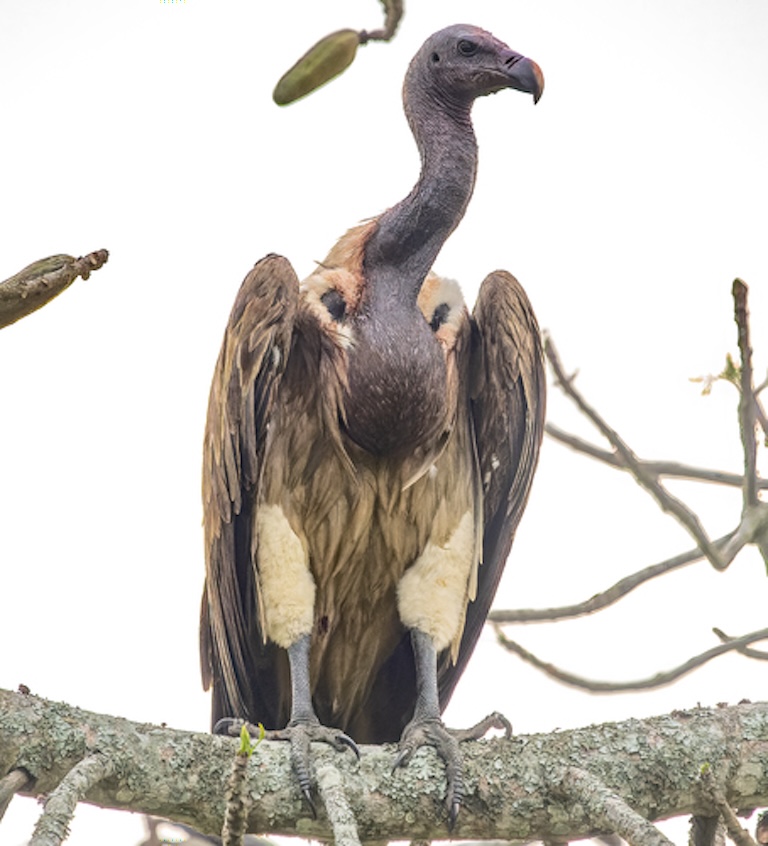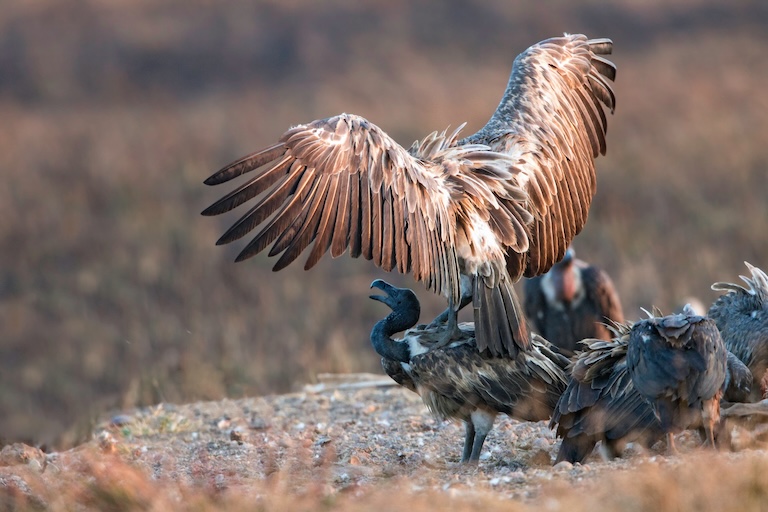Slender-billed Vulture Profile
Southeast Asia is home to some of the fastest-growing economies on Earth. Unfortunately, like everywhere else, this rapid growth is coming at an environmental cost, and animals that were once widespread are now rarely, if ever seen.
The Slender-billed vulture is a good example of this, and while its decline in Southeast Asia has been a long and slow process, in recent years it’s experienced a terrifying drop in numbers and is now threatened with imminent extinction across the rest of its range too.

Slender-billed Vulture Facts Overview
| Habitat: | Remote, open country and forested areas |
| Location: | Southeast Asia and the Himalayas |
| Lifespan: | Unknown, likely more than 40 years |
| Size: | 77–103 cm (30 to 40.5 in) long, 196–258 cm (77 to 101.5 in) wingspan |
| Weight: | 4-7 kg (9-16 lbs) |
| Colour: | Mottled brown with a black beak and feet |
| Diet: | Carrion |
| Predators: | None |
| Top Speed: | More than 55 km/h (34 mph) |
| No. of Species: | 1 |
| Conservation Status: | Critically Endangered (IUCN) |
The Slender-billed vulture is a relatively new species of vulture to science, recently separated from the Indian vulture but similar in size and weight.
While it’s a medium-sized vulture, this is an enormous bird and soars at great altitudes in remote regions of India and Southeast Asia.
Unfortunately, despite its preference for undisturbed environments, there are few such places remaining, and its historical decline in Southeast Asia is now being surpassed and compounded by its rapid removal at the hands of animal agriculture.
But reintroduction programs have helped, and while the population isn’t yet growing, the decline appears to have subsided.
Interesting Slender-billed Vulture Facts
1. They used to be Indian vultures
Until 2009, this species was thought to be one and the same as Gyps indicus, or the Indian vulture. The two birds are similar, but it has been determined that they have non-overlapping habitats and are distinct enough to be considered separate species.
Both are griffon vultures, a genus of enormous and powerful Old World vultures with slender heads and a ruff of feathers that makes them look a bit like the Skeksis from Dark Crystal.
Unfortunately for the slender-billed vulture, the discovery that it was a distinct species from G. indicus meant that it was suddenly a lot less populous than everyone thought it was, and while both are critically endangered, it is now the more endangered of the two. 1

2. They’re huge
The slender-billed vulture, like the Indian vulture, is about 10% larger than the related white-rumped vulture. This puts it at a maximum weight of around 7 kg and a wingspan of around 2.6 meters across.
This large and heavy bird is still not close to the largest of the vultures but is a behemoth nonetheless.
It feeds almost exclusively on carrion and tries to avoid human-infested areas, which you’d think would make it entirely out of reach of human interference, but unfortunately, this isn’t the case.
3. They’re in serious trouble
There are around 23 species of Old-World vulture, 8 of which are Griffon vultures, and five of these—including the slender-billed vulture—are critically endangered. Three are found in Africa, one across Eurasia, and the other four exclusively in Asia.
These huge birds were once widespread, but some species are now almost entirely wiped out, with declines of more than 97% in just 12 years.
In Southeast Asia, they’re now restricted to two isolated populations, and in India and Nepal, their range has shrunk by more than half. There are multiple reasons for this decline, and some are more urgent than others.
4. Humans ate all their food
The slender-billed vulture has been facing an ongoing drop in numbers in Southeast Asia for decades. This decline corresponds with a decrease in large wild animals as human agriculture takes over the land.
Vultures have been historically vilified, too, because they are large raptors, and people see them eating carcasses and assume the vulture did the killing. While this is a false assumption, it still leads to revenge killings by farmers, which is another factor affecting their historical decline.
With nothing to eat, the population naturally decays, but this process—while ultimately devastating—can be slow enough to act upon. But this isn’t the most urgent issue facing the species.
5. Then poisoned them
By the mid-2000s, vultures from the Gyps genus were dropping dead all over the Indian subcontinent. It was discovered that the anti-inflammatory drug diclofenac, used to treat domestic livestock, was lethally toxic to vultures and directly responsible for these deaths.
With few wild animals left, the vultures’ only source of food became deceased livestock, and the poisonings became widespread and devastatingly fast.
With a lot of pressure from conservation organizations, widespread bans on the drug came into play, but many of these were not enforced, so the problem persisted. The slender-billed vulture population dropped to less than 3% in just 12 years.
Still, since the ban, the decline has slowed, and other efforts are working to stem the tide in different ways.

6. Reintroduction programs began
Being one of the most threatened bird species, breeding programs have been underway to attempt to help restore wild populations of slender-billed vultures, and by 2009, when there were just 1000 of the birds left in the wild, the first chicks were hatched.
India led the first captive breeding scheme, and others followed suit, and since then, some progress has been made. 2 3
7. Populations might now be stable
Since the reintroduction programs made the headlines, there was a drop in interest by the media, and not much was spoken about the ongoing plight of Gyps species, but behind the scenes, conservation programs continued to slave away, and researchers continued to monitor progress.
A recent survey shows that diclofenac is still being widely used in India, while in Nepal its use is far less, and the population trends of the vultures living in these regions reflect this, showing more promising outcomes for the Nepalese populations.
Other researchers have shown positive results with slow but promising improvements in other regions, and overall, the population may tentatively be considered stable, yet still incredibly low. 4
Slender-billed Vulture Fact-File Summary
Scientific Classification
| Kingdom: | Animalia |
| Phylum: | Chordata |
| Class: | Aves |
| Order: | Accipitriformes |
| Family: | Accipitridae |
| Genus: | Gyps |
| Species: | tenuirostris |
Fact Sources & References
- Muhammad Arshad (2008), “Phylogeny and phylogeography of critically endangered Gyps species based on nuclear and mitochondrial markers”, Springer Nature Link.
- “Indian vulture births are hailed”, News BBC.
- Press Association (2009), “Boost for endangered vultures after captive breeding success”, The Guardian.
- Vibhu Prakash (2024), “Recent trends in populations of Critically Endangered Gyps vultures in India”, Cambridge University Press.
